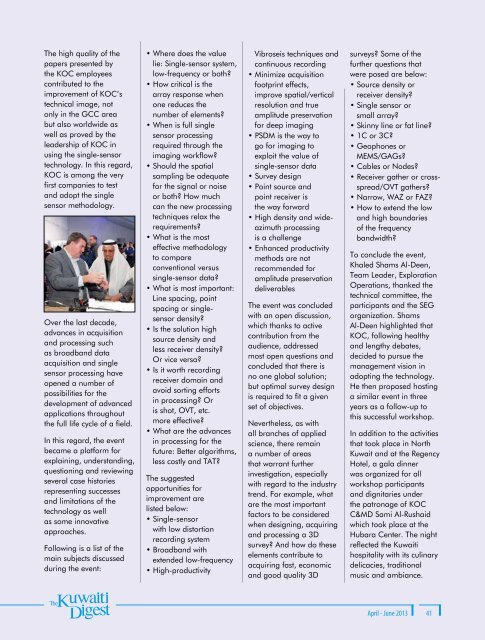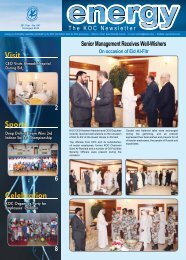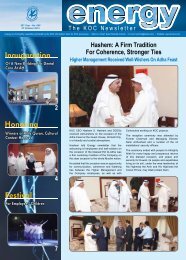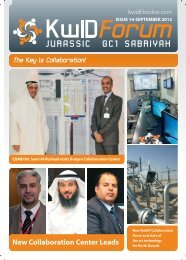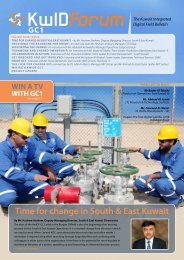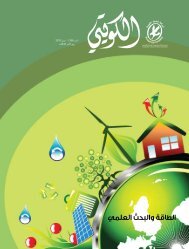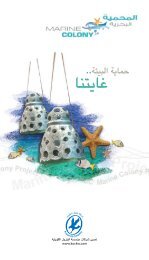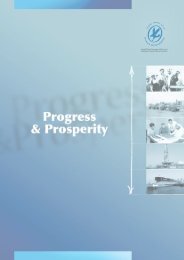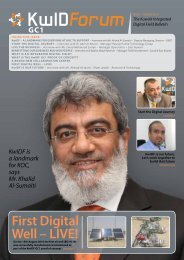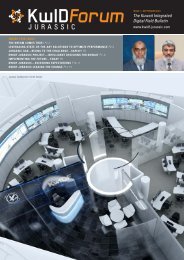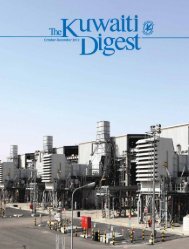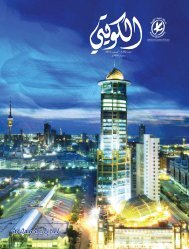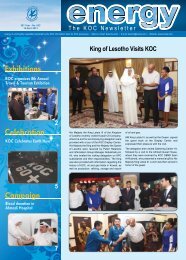6 - Kuwait Oil Company
6 - Kuwait Oil Company
6 - Kuwait Oil Company
You also want an ePaper? Increase the reach of your titles
YUMPU automatically turns print PDFs into web optimized ePapers that Google loves.
The high quality of the<br />
papers presented by<br />
the KOC employees<br />
contributed to the<br />
improvement of KOC’s<br />
technical image, not<br />
only in the GCC area<br />
but also worldwide as<br />
well as proved by the<br />
leadership of KOC in<br />
using the single-sensor<br />
technology. In this regard,<br />
KOC is among the very<br />
first companies to test<br />
and adopt the single<br />
sensor methodology.<br />
Over the last decade,<br />
advances in acquisition<br />
and processing such<br />
as broadband data<br />
acquisition and single<br />
sensor processing have<br />
opened a number of<br />
possibilities for the<br />
development of advanced<br />
applications throughout<br />
the full life cycle of a field.<br />
In this regard, the event<br />
became a platform for<br />
explaining, understanding,<br />
questioning and reviewing<br />
several case histories<br />
representing successes<br />
and limitations of the<br />
technology as well<br />
as some innovative<br />
approaches.<br />
Following is a list of the<br />
main subjects discussed<br />
during the event:<br />
• Where does the value<br />
lie: Single-sensor system,<br />
low-frequency or both<br />
• How critical is the<br />
array response when<br />
one reduces the<br />
number of elements<br />
• When is full single<br />
sensor processing<br />
required through the<br />
imaging workflow<br />
• Should the spatial<br />
sampling be adequate<br />
for the signal or noise<br />
or both How much<br />
can the new processing<br />
techniques relax the<br />
requirements<br />
• What is the most<br />
effective methodology<br />
to compare<br />
conventional versus<br />
single-sensor data<br />
• What is most important:<br />
Line spacing, point<br />
spacing or singlesensor<br />
density<br />
• Is the solution high<br />
source density and<br />
less receiver density<br />
Or vice versa<br />
• Is it worth recording<br />
receiver domain and<br />
avoid sorting efforts<br />
in processing Or<br />
is shot, OVT, etc.<br />
more effective<br />
• What are the advances<br />
in processing for the<br />
future: Better algorithms,<br />
less costly and TAT<br />
The suggested<br />
opportunities for<br />
improvement are<br />
listed below:<br />
• Single-sensor<br />
with low distortion<br />
recording system<br />
• Broadband with<br />
extended low-frequency<br />
• High-productivity<br />
Vibroseis techniques and<br />
continuous recording<br />
• Minimize acquisition<br />
footprint effects,<br />
improve spatial/vertical<br />
resolution and true<br />
amplitude preservation<br />
for deep imaging<br />
• PSDM is the way to<br />
go for imaging to<br />
exploit the value of<br />
single-sensor data<br />
• Survey design<br />
• Point source and<br />
point receiver is<br />
the way forward<br />
• High density and wideazimuth<br />
processing<br />
is a challenge<br />
• Enhanced productivity<br />
methods are not<br />
recommended for<br />
amplitude preservation<br />
deliverables<br />
The event was concluded<br />
with an open discussion,<br />
which thanks to active<br />
contribution from the<br />
audience, addressed<br />
most open questions and<br />
concluded that there is<br />
no one global solution;<br />
but optimal survey design<br />
is required to fit a given<br />
set of objectives.<br />
Nevertheless, as with<br />
all branches of applied<br />
science, there remain<br />
a number of areas<br />
that warrant further<br />
investigation, especially<br />
with regard to the industry<br />
trend. For example, what<br />
are the most important<br />
factors to be considered<br />
when designing, acquiring<br />
and processing a 3D<br />
survey And how do these<br />
elements contribute to<br />
acquiring fast, economic<br />
and good quality 3D<br />
surveys Some of the<br />
further questions that<br />
were posed are below:<br />
• Source density or<br />
receiver density<br />
• Single sensor or<br />
small array<br />
• Skinny line or fat line<br />
• 1C or 3C<br />
• Geophones or<br />
MEMS/GAGs<br />
• Cables or Nodes<br />
• Receiver gather or crossspread/OVT<br />
gathers<br />
• Narrow, WAZ or FAZ<br />
• How to extend the low<br />
and high boundaries<br />
of the frequency<br />
bandwidth<br />
To conclude the event,<br />
Khaled Shams Al-Deen,<br />
Team Leader, Exploration<br />
Operations, thanked the<br />
technical committee, the<br />
participants and the SEG<br />
organization. Shams<br />
Al-Deen highlighted that<br />
KOC, following healthy<br />
and lengthy debates,<br />
decided to pursue the<br />
management vision in<br />
adopting the technology.<br />
He then proposed hosting<br />
a similar event in three<br />
years as a follow-up to<br />
this successful workshop.<br />
In addition to the activities<br />
that took place in North<br />
<strong>Kuwait</strong> and at the Regency<br />
Hotel, a gala dinner<br />
was organized for all<br />
workshop participants<br />
and dignitaries under<br />
the patronage of KOC<br />
C&MD Sami Al-Rushaid<br />
which took place at the<br />
Hubara Center. The night<br />
reflected the <strong>Kuwait</strong>i<br />
hospitality with its culinary<br />
delicacies, traditional<br />
music and ambiance.<br />
April - June 2013 41


